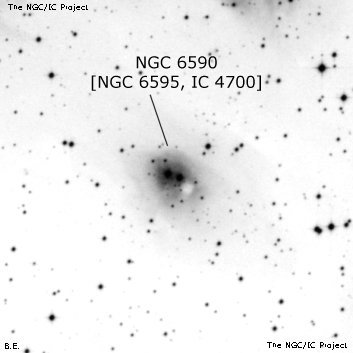NGC/IC Project Restoration Effort
(This is a very very beta version)
NGC6590


Basic Information
Location and Magnitude
Right Ascension: 18:17:4.8
Declination: -19:51:58
Constellation: SGR
Visual Magnitude:
Historic Information
Discoverer: Swift L.
Year of discovery: 1885
Discovery aperture: 16.0
Observational
Summary description: D * in centre of pF, pL, R neby
Sub-type: EN+OCL
Corwin's Notes
=====
NGC 6590 = NGC 6595 = IC 4700. JH found the brightest nebula in this group
while observing at Slough; his position is good. Swift came across it and
another nearby nebula nearly 60 years later in 1885, but misplaced both by
about 45 seconds of time in RA from the correct positions. In a note in AN
3101, Barnard corrected the positions for both of Swift's objects, noting the
identity of N6590 with N6595. He also announced the discovery of another
larger, though fainter nebula (IC 1284) northeast of the brighter pair. (In
still another note in AN 3111, Barnard also announced the discovery of yet
another nebula here, IC 1283. See that for more).
Curiously, Barnard mentions the AN 3111 note in AN 4239, but not the AN 3101
note. Had he done so, it might have alerted Dreyer to the identity of one of
Barnard's nebulae mentioned there (see NGC 6589 for the passage) with NGC
6595. Had this happened, Dreyer probably would not have been included it in
the second IC.
ESO, by the way, notes the cluster associated with the nebula. On the optical
DSS images, the cluster appears to be centered about 15 seconds of time to the
west. I suspect that the two bright stars near the center of the nebula are
also involved with the nebula, so I've adopted the mean of their positions as
that for the object.
Steve's Notes
=====
NGC 6590
17.5" (8/18/01): at 100x, this reflection nebula appears as a bright, round glow surrounding a similar pair (h2827) of 10th magnitude stars separated by 20". The glow is fairly large, extending roughly 4' in diameter. Forms a similar pair of RN with NGC 6589 6' NNW. The entire field is weakly glowing and this nebulosity is connected to the large region IC 1283/84 to the NE. A dark patch or globule on the NW side was not seen with certainty.
17.5" (6/20/87): at 88x with UHC filter appears as a bright, prominent nebulosity surrounding a pair of mag 10 stars. Similar or slightly larger than NGC 6589 in field 7' NNW.
13" (7/16/82): moderately bright, small, surrounds a closely matched double star.



